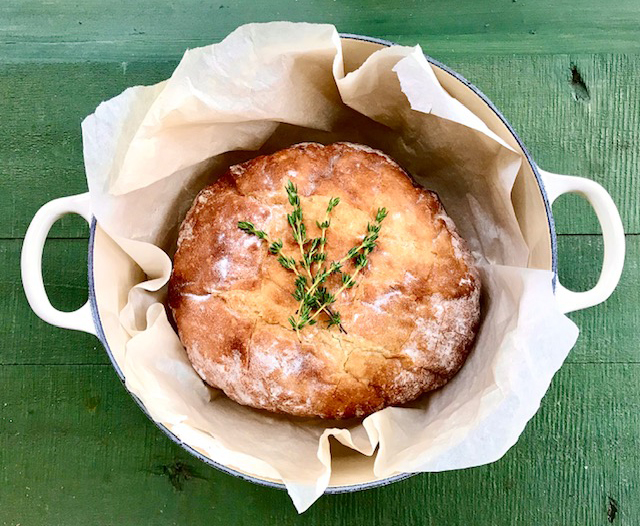
Rosemary Thyme No-Knead Dutch Oven Bread
INGREDIENTS
3 cups all-purpose flour
1/2 tsp instant yeast
1 1/2 tsp salt
1 1/2 tbsp fresh rosemary finely chopped
1 1/2 tbsp fresh thyme chopped
1 1/4 cups room temperature water
1/4 cup olive oil
INSTRUCTIONS
In a large bowl, combine flour, yeast, salt, rosemary, and thyme. Stir in water and olive oil with a wooden spoon until dough is well-mixed and flour is fully incorporated. The dough will be wet and uneven.
Cover the bowl in plastic wrap and let it rest in a warm spot in your kitchen for 10-18 hours. The dough will double in size and be puffy.
Dust a clean work surface with flour and dump the dough out from the bowl, using your hands. Fold the dough over a few times so it's a bit more stable. Gather the dough into a ball by gently stretching the top and pulling the ends underneath the loaf.
Brush a piece of parchment paper with a bit of olive oil. Place your dough onto the parchment and cover with a damp kitchen towel or paper towel. Place in a warm spot in the kitchen and let rise for an additional hour to hour and a half.
30 minutes before you plan to bake your bread, place a large Dutch oven with lid or (other heavy, lidded, oven-safe pot) into your oven and preheat to 500 degrees. Make sure your pot and lid can be heated to 500 degrees.
When you're ready to bake your bread, use a serrated knife to cut one or more slits in the top of the bread dough. This allows the bread to expand when it hits the heat of the oven without cracking, makes it look beautiful, and gives you nice craggy edges along your cuts.
Take the preheated Dutch oven out of your oven. Lift the dough loaf by the corners of the parchment paper and lower the whole thing into your Dutch oven, parchment and all. Cover with the lid and re-insert into the oven.
Lower the heat to 425 degrees and bake, covered, for 30 minutes.
Remove the lid and bake for an additional 15 minutes. Place the loaf on a wire rack to cool.
